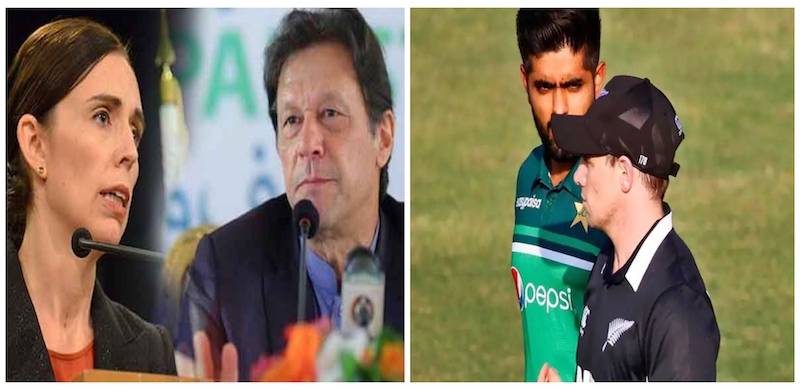
On Thursday, Pakistan claimed that the warning that there was threat of terror attack from Islamic State-Khorasaan (IS-K Pakistan) against the New Zealand team had emanated from Indian accounts and was part of a conspiracy to damage cricket in the country. Federal Information Minister Fawad Chaudhary disclosed that the chain of events started with a social media post belonging to what he termed as a fake account of former spokesman of the banned TTP Ehsanullah Ehsan. But in a message widely circulated on various platforms, a man claiming to be Ehsanullah Ehsan said he had indeed posted the message from his genuine account. The veracity of the claim is yet to be established.
On the other hand, New Zealand team sources had on September 17 disclosed to Pakistan Cricket Board (PCB) officials that the team decided to abandon the tour and return home after the New Zealand government received an alert from the ‘Five Eyes’ intelligence group about a ‘direct and imminent’ threat to its team.
The Five Eyes (FVEY) is an intelligence alliance comprising Australia, Canada, New Zealand, the United Kingdom, and the United States. These countries are parties to the multilateral UKUSA Agreement, a treaty for joint cooperation in intelligence.
No detailed account is available about how the threat was discovered by the FVEY and when. On the other hand what has been revealed so far about the Indian connections appears rather too questionable to merit its acceptance or otherwise without a more intrusive investigation.
The origins of the FVEY is traced back to informal secret meetings during World War II between British and US code-breakers that started before the US entry into the war, followed by the Atlantic Charter agreed by the Allies to lay out their goals for a post-war world.
In spite of continued controversy over its methods, the Five Eyes relationship is said to be one of the most comprehensive known espionage alliances in history.
In the aftermath of the September 11 the surveillance capabilities of the Five Eyes were greatly increased as part of the global War on Terror.
No detailed account is available about how the threat was discovered by the FVEY and when. On the other hand what has been revealed so far about the Indian connections appears rather too questionable to merit its acceptance or otherwise without a more intrusive investigation.
Of course, there is no proof yet that the Indian government may be involved in this conspiracy but one cannot rule out the possibility as well. But blaming India or Indians for anything going wrong in or for Pakistan invariably comes as reflex response from official Pakistan. Indeed, it could be a far-fetched idea, but ever since the EU DisinfoLab’s revelations, it is quite evident that such organised smear campaigns against Pakistan have Indian roots.
It, however, defies credulity that a decision to abandon the tour minutes before the start of the first ODI could have been taken by a country like New Zealand on the warning from such a moot source even if it is granted that it actually came from a reformed former spokesman of the banned terror organisation; who had escaped from a Pakistan safe house only last year and; who has not yet publicly disassociated himself from TTP.
The TTP is at war with Pakistan and has already caused the country huge losses in men and materials since it began its terror activities in 2007 against our Army, Police and Intelligence Agencies. In one horrible attack on a school the TTP has killed more than hundred young students.
Many of the TTP militants fled to Afghanistan in 2010 through the ungoverned areas of the Afghanistan–Pakistan border with some joining Islamic State of Iraq and the Levant – Khorasan Province. As of 2019, there were said to be around 3,000 to 4,000 TTP militants in Afghanistan, according to a report by United States Department of Defense. The TTP have continued their terror attacks against Pakistan from across the border.
President Ashraf Ghani’s government was known to have extended tacit support to the TTP fighters. And now after the return of Taliban to Kabul, the TTP has intensified their operations inside Pakistan, especially in the border areas in KP and Balochistan.
Many of the TTP militants fled to Afghanistan in 2010 through the ungoverned areas of the Afghanistan–Pakistan border with some joining Islamic State of Iraq and the Levant – Khorasan Province.
It has been established without an iota of doubt that the threat warning was, indeed, received (even if we discard our official claim blaming India). Therefore, the decision of New Zealand to go home on the warning of FYFV without playing their scheduled matches or England team’s reluctance to come in October shows that the world instead of punishing Pakistan for its tacit support to the Afghan Taliban is extending help by saving it from global humiliation and embarrassment of witnessing the ignominy of a terror attack on a touring cricket team.
Meanwhile, the Taliban’s return to power in Afghanistan has boosted the morale of numerous jihadist groups operating in various parts of the world. Among those groups is Hayat Tahrir al-Sham (HTS), a Syrian jihadist group affiliated with Al Qaeda that currently controls the last rebel-held enclave of Idlib, Syria. It was among the loudest to celebrate the Taliban’s rise to power. On the day the Taliban captured Kabul, HTS dispatched its fighters to distribute sweets in Idlib’s market squares, wave the Taliban’s flag, and chant ‘Allahu akbar’.
In a statement, the HTS officially congratulated the Taliban and promised to derive “steadfastness from such living experiences,” with an eye to recruiting more Syrians to continue fighting Syrian President Bashar al-Assad.
These developments call for a more extensive and in-depth intelligence surveillance inside the country as well as along the Pakistan-Afghanistan borders. More so because Taliban seem to be finding it increasingly difficult to cope with the re-emergence of Al-Qaeda and IS-Khorasan in Afghanistan.

